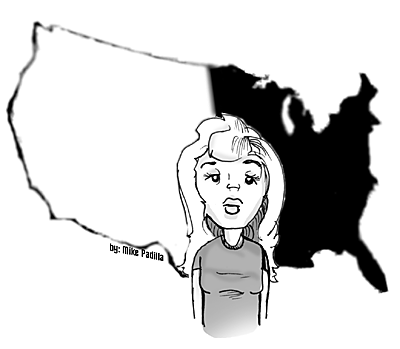
Illustration by Mike Padilla
|
|
By Rui Wang
Arizona Daily Wildcat
Wednesday, March 30, 2005
Print this
The newspaper likes to slap a goofy, smiling mug shot next to my column each week.
But if there was no picture next to this column, and I had an androgynous name - which, I know, is a stretch - would you or my editor at the opinions desk perceive my ideas differently? If I were a man, would that affect the way I wrote this column, and would that in turn affect the way you read this column?
Diversity in journalism is a fascinating topic for me as a woman, as a minority and as a writer. Despite my interest, however, the latest debate on the scarcity of female opinion writers feels like one of those tricked-out SUVs with the spinning rims that you see occasionally at red lights: a lot of flash and commotion, but not moving forward.
A little background: The percentage of female columnists published in The New York Times, Washington Post and Los Angeles Times during the first two months of 2005 ranged between 10 percent and 20 percent. Earlier this year, Michael Kinsley, the opinions editor at the Los Angeles Times and Susan Estrich, a feminist law professor at the University of Southern California, sparred privately via e-mail over the lack of women writers at the Times.
The Kinsley-Estrich e-mails, filled with surprising levels of rancor, were eventually made public and ignited discussion on opinion pages around the country. The reaction from many women writers? "Get over it already."
Perhaps it's because we're controversied-out. After all, this follows on the heels of the women in science debate that was ignited by Harvard President Larry Summers.
The lack of women columnists is somewhat more puzzling in that women have consistently performed on par or better than their male counterparts on standardized verbal and writing tests. There is no shortage of women in English and the liberal arts. At least in math and science, standardized testing in the United States shows that females perform substantially worse. The number of women in science, particularly at the upper reaches of the discipline, is very small.
Because of these statistics, the usual suspects of discrimination and socialization don't fully explain why women are as misrepresented in the journalism realm as in the sciences.
There's something more fundamental at work. The difference between female and male styles of expression helps explain the disparity.
Gail Collins, the first female New York Times opinions editor, remarks that women approach commentary in a different way: "(T)here are probably fewer women, in the great cosmic scheme of things, who feel comfortable writing very straight opinion stuff ... and batting something out." In other words, women don't like to write with a hard-line. They're also not interested in playing "Hardball" or engaging in "Crossfire."
Collins' theory is buoyed with observations made by top female law professors who disfavor the Socratic method of teaching in order to encompass female students who prefer nuanced discussions rather than shoot-from-the-hip question and answer sessions.
It also lends credence to Larry Summers' theory that there exist innate differences between male and female brains that affect how each gender thinks. This would naturally apply not only to scientific thought but writing style as well. This is not to say that these innate differences affect the quality of writing between men and women.
Consider two of The New York Times' best columnists: Maureen Dowd, who Michael Kinsley calls one of the best commentators writing today, and Thomas Friedman, a Pulitzer Prize winner. These two writers in no way represent all male and all female opinion columnists, but their styles illustrate some of the differences. Friedman is more straightforward; he likes to write columns where he sets out a problem in the first half, and in the second half, suggests a list of bullet-point solutions. Dowd draws in literary analogies and imagery, circling in on her point in a less deliberate way. Both are extremely powerful writers.
We live in a time and a place where subtlety and nuance, especially when it comes to intellectual thought, are out of vogue. The leader of our country views the world in severe shades of black and white. Thirty-second media sound bites simplify the issues even more. The most effective attack against a presidential candidate is that he is guilty of complexity: "waffling," "flip-flopping" and not being able to take a stand.
Newspaper readers, as well as newspaper editors, are not immune to this trend. It may explain why women writers, with their particular expressive style, choose to avoid writing for the opinions page. It may also explain why women opinion writers are not published as often.
Against this backdrop, how can opinion writers who take a complex, holistic approach - female or not - prevail on a national level?
Rui Wang is a third-year law student. She can be reached at letters@wildcat.arizona.edu.
